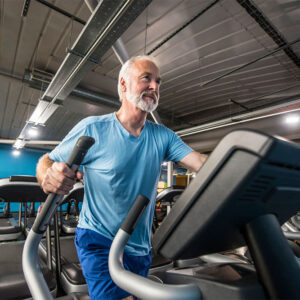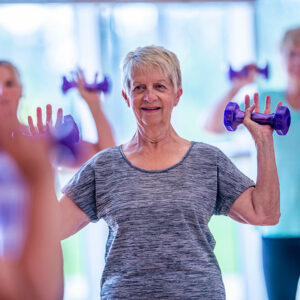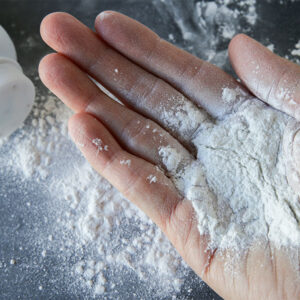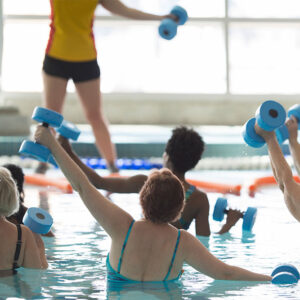
Do This One Simple Thing to Keep Your Joints Younger for Longer
- Discover the age-related changes that make your joints hurt
- This one thing is key to keeping you mobile in your older years. Find out more…
- Three ways to wave goodbye to joint pain and stiffness.
Dear Living Well Daily Reader,
“OOOUUUCCCH! When did getting out of a chair start hurting so much?!?”
A few weeks ago, when I was visiting my family, this is what my dad asked me as he got out of his chair.
Like many folks, my father suffers from joint and muscle stiffness. And while during most of the year he walks about 2–3 miles a day with his loyal walking partner, a dog named Bruce, he’s lucky to get in half a mile during the blazing-hot Florida summer.
It’s in these months that he experiences more pain and stiffness than usual. And as it seems, there is a good reason for this, which I will share in just a bit. Fortunately, there is a solution for my father and anyone else who suffers from chronic joint pain and stiffness.
That’s why we have invited our colleague, Lisa Ball, of Plum Dragon Herbs and Dit Da Jow, to help explain some of the reasons why joint stiffness and pain occur and the best way to help keep your joints younger for longer.
Plus, she will tell you about some amazing, 100 percent natural herbal products that may alleviate joint pain and stiffness.
Take it away, Lisa…
Do This One Simple Thing to Keep Your Joints Younger for Longer
Everyone knows that our bodies change as we age, but what does that look like up close at the joints? And, more importantly, what can we do to keep them younger for longer? We are going to answer these questions for you and tell you about some awesome 100 percent natural herbal products you can use to help heal injuries and pain, and condition joints and connective tissue.
![]() Decreases in Muscle Fibers
Decreases in Muscle Fibers
As you age, there is usually a decrease in the size and number of muscle fibers, especially if you’re sedentary. This causes your remaining muscle tissue to have a slower response time. Almost everyone experiences a noticeable change in their quickness as they approach their 40s and 50s. This puts more stress on the remaining muscle fibers when they try to perform at the same level, and that extra stress raises your risk of strains and pulled muscles.
![]() Lower Cardiac Output
Lower Cardiac Output
The heart’s a muscle too, so when it starts performing at a lower level, less blood is delivered to your muscles and joints for fuel and recovery. You’ll notice that your endurance capacity isn’t what it used to be, and that recovering from strenuous work takes longer. When full recovery takes longer, it’s easier to build up cumulative damage to a point where something tears.
![]() Fluid Loss in Connective Tissues
Fluid Loss in Connective Tissues
At any age, connective tissue has a very low blood supply compared to other tissues, so things like nutrient delivery and recovery time are always fairly slow compared to tissues like muscle and skin.
But as you age, the challenge deepens because there is often an overall loss of water in tendon, ligaments, and cartilage, which makes them lose some of their cushion and flexibility.
This rigidity makes them more vulnerable to stress. So, when you are coming back down from that jump shot in basketball, the Achilles tendon in your heel is not going to provide as much shock-absorbing help and can tear in the process.
Combine lower cardiac output and higher stress, and tendons (which are like fibrous cords that attach muscles to bone) can reach a point where they never have time to fully recover. Damage accumulates until a joint is chronically inflamed.
Ligaments (which connect bone to bone) have an even weaker blood supply than tendons and can be particularly hard to repair when damage accumulates.
Cartilage, which has no blood supply at all, can also suffer the same kind of cumulative damage. Just like ligaments and tendons, it loses its water content, providing less cushion and making it more likely to be damaged when stress is placed on a joint. Constant joint loads can wear it away until signs of arthritis start showing up.
![]() Why Motion and Challenge Are the Answer
Why Motion and Challenge Are the Answer
Physiology experts of all shades, including the American Academy of Orthopedic Surgeons, confirm that the most effective way to slow age-related changes in muscles, ligaments and joints is by remaining active in ways that both stretch and challenge muscles and connective tissue. It’s not just age, but the lack of movement and use of muscles that allow the aging process to speed up.
Even if you’re eating calcium- and vitamin D-rich foods, popping a handful of glucosamine and chondroitin pills and drinking traditional bone broth, you still have to move those joints in order to help all that goodness get to where it can do some good.
Pilates, swimming, yoga and many other forms of exercise that incorporate flexibility simultaneously provide great benefits for joint health. The goal is to keep every part of the joint moving (with appropriate rest in between, of course).
Exercise doesn’t have to be strenuous, but it should be consistent, and it should at least be challenging enough to send the signal to your muscles that they have a reason to stick around.
![]() Liniments Can Extend What Exercise Begins
Liniments Can Extend What Exercise Begins
Certain liniments can have both a healing and conditioning effect on connective tissues and can have dramatic pain-relieving effects:
- If it’s conditioning you’re after, it’s hard to do better than our Ancestors Advanced Dit Da Jow. If you know you need to strengthen a particular area of the body that has been weakened for some time, or if you sustained an injury that has never fully healed, this is the formula for you
- If you’re already dealing with a fresh painful and swollen or bruised injury, Bruise Juice is excellent for helping with the inflammation, redness/bruising and swelling and pain of fresh injuries
- Or, you can get the best of both worlds with Ho Family Dit Da Jow, our best-selling formula known for both its conditioning properties and its ability to reduce pain and accelerate healing from injuries caused by overuse. (Please note this formula is NOT for fresh injuries where bruising and swelling are still present. This formula is best for chronic injury and pain.)
Click here to find out more about the amazing powers of Plum Dragon’s Dit Da Jow!
Lisa Ball
CEO, Plum Dragon Herbs and Dit Da Jow.
As always, check with your doctor before starting a new herbal product.
And let us know if you have used a dit da jow before! Write me at nmoore@lfb.org
Live well,

Natalie Moore
Managing editor, Living Well Daily
Written By Natalie Moore
Natalie Moore is a dedicated health researcher with a passion for finding healthy, natural, and science-based solutions. After a decade of direct healthcare experience in western and natural medicine, she was involved in public health research before joining Living Well Daily.
View More Free Articles
The Secret Ingredient to a Longer, Happier Life
Let’s face it. We’re all in need of an attitude adjustment from time to time. After all, when you turn on the news these days, the world can seem pretty dark. That is unless you make it a practice to look for the silver linings. In fact, Harvard researchers say when you do, something quite...
Do You REALLY Need All Those Skincare Products?
I often get questions about skincare products—and here’s what I’ve learned. In today’s beauty-obsessed world, it’s easy to fall into the trap of spending hundreds every month believing you need countless products to fight aging and achieve healthy, glowing skin. However, many dermatologists argue that LESS is MORE when it comes to skincare. Simplifying your...
“Ebb and Flow” Technique TRANSFORMS Senior Brain Health
You know by now that exercise is good for you. It keeps your heart healthy, your muscles strong, and your waistline trim. But what if I told you that a trendy “ebb and flow” workout technique—often associated with young fitness enthusiasts—could actually be a game-changer for us “oldsters” when it comes to brain health? And...
Mailbag: Slash Your Risk of Bone Fractures as You Age
“My doctor recently told me that I have osteoporosis. What can I do to reduce my risk of fractures and maintain strong bones as I age?” – Margaret Hi Margaret, Sorry to hear about your diagnosis. I’m sure it was a shock. Osteoporosis is a serious condition that affects millions of people, and it’s not...
Household Favorite EXPOSED as Cancer Risk?
We all want to believe that the products we use daily are safe. After all, if they weren’t, they wouldn’t be on store shelves, right? Well, I hate to break it to you, but sometimes, the truth is far more alarming than we’d like to admit. The World Health Organization (WHO) has just dropped a...
Hidden Heatwave Threat REVEALED
Heat waves can have serious consequences. After all, staying cool isn’t just a comfort issue. When the mercury soars, it threatens your health—especially when you’re a senior. There are various reasons for this, including chronic medical conditions and bodies that just don’t regulate temperature as well as they once did. But there’s another heat-linked threat...
The Hidden Threat Behind Your Achy Joints
Picture this… You’re trying to enjoy a leisurely stroll in the park, but each step sends a jolt of pain through your knee. Or maybe you’re attempting to open a stubborn jar lid, only to have your fingers refuse to cooperate, leaving you feeling frustrated and helpless. Perhaps you’re simply trying to get out of...
Parkinson's Signs You Can't Afford to Miss
Imagine waking up one day to find your body betraying you. Your hands tremble as you try to button your shirt. Your feet shuffle when you want to walk with purpose. Once strong and clear, your voice now barely reaches above a whisper. This is the reality for those living with Parkinson’s. But what if...
Do Protein Needs Drop with Age? The SURPRISING Answer
I had a patient ask me the other day if they needed as much protein now as when they were younger. After all, we aren’t quite as active as seniors compared to when we were spring chickens. It’s a good question. And the answer might surprise you… Remember when you could devour a whole pizza...
Follow Your “Gut Feeling” to Reduce Diabetes Risk
It seems like every day we learn something new about the incredible influence our gut has on our overall health. From mood to immunity, and even to how well we sleep, the community of microbes in our digestive tract is pulling the strings behind the scenes. So, it should come as no surprise that researchers...









